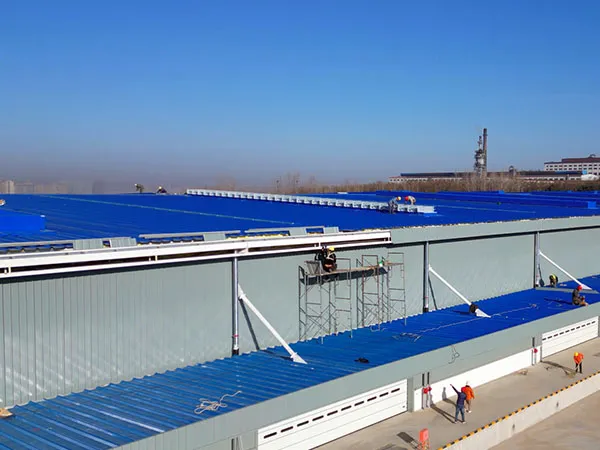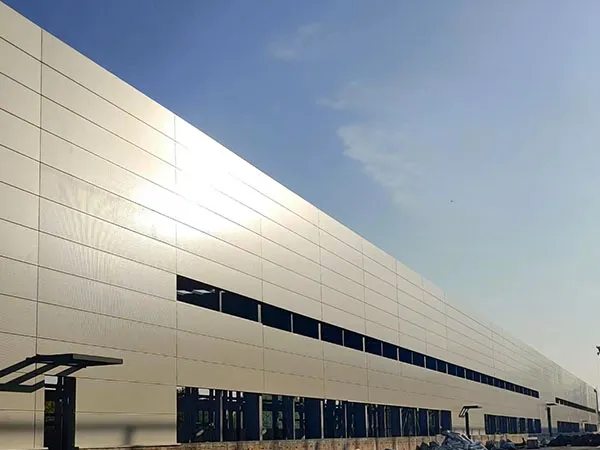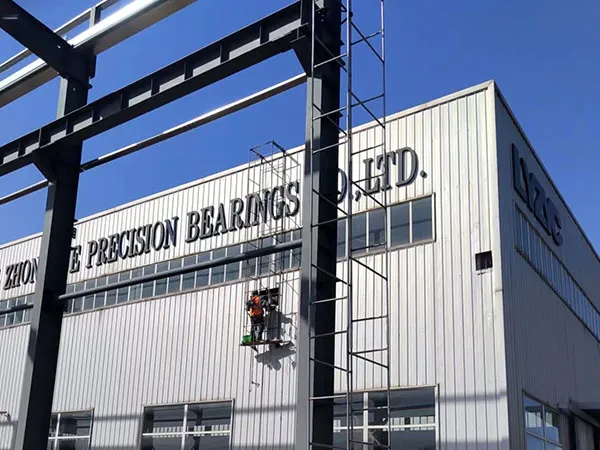Time:2025-05-13 03:22:34 Source:Sanjian Meichen Steel Structure
Steel-structured factories, owing to their exceptional strength, construction speed, and design flexibility, occupy a central position in industrial architecture worldwide. However, steel's inherent properties also present significant challenges in certain environments: corrosion and fire. These issues not only severely impact the service life and safety of steel structures but can even have catastrophic consequences. Therefore, developing and implementing comprehensive, scientific anti-corrosion and fire prevention measures is crucial to ensuring the long-term, stable operation of steel-structured factories. This article will delve into the key threats facing steel-structured factories and detail preventative and protective strategies, from design to maintenance.
Challenges and Countermeasures for Corrosion Prevention in Steel Structures
Steel corrosion is a complex electrochemical process influenced by a variety of factors, including ambient humidity, oxygen, chemical media (such as acids, alkalis, and salts), temperature, and the surface condition of the steel. Corrosion not only weakens the load-bearing capacity of steel but also causes structural deformation, joint failure, and ultimately, collapse.
Types and Mechanisms of Corrosion
Uniform corrosion: Large-scale, uniform corrosion of the steel surface.
Pitting corrosion: Small, deep pits form in localized areas and are extremely destructive.
Crevice corrosion: Occurs in narrow crevices (such as connectors and bolt holes) due to differences in oxygen concentration.
Galvanic corrosion: When two dissimilar metals come into contact, the more reactive metal experiences accelerated corrosion.
Stress corrosion cracking: Occurs under the combined effects of tensile stress and specific corrosive media.
High-performance anti-corrosion coatings: Choose a primer, midcoat, and topcoat system with excellent adhesion, weathering, and chemical resistance. For example, zinc-rich primers provide electrochemical protection, epoxy midcoats offer an excellent physical barrier, and polyurethane topcoats offer UV and abrasion protection.
Pre-coating surface preparation: Ensure the steel surface is clean, oil-free, and rust-free. Sandblasting is typically used to remove rust to Sa2.5 to ensure good adhesion between the coating and the substrate.
Strict coating procedures: Ensure uniform coating thickness, no gaps or bubbles, and strictly adhere to recoating intervals.
Hot-dip galvanizing: Long-lasting sacrificial anodic protection: By immersing steel components in molten zinc, a zinc-iron alloy layer and a pure zinc layer are formed on the surface. The zinc layer acts as a sacrificial anode, corroding preferentially, thereby protecting the steel substrate.
Advantages: The coating is uniform and dense, providing comprehensive protection even for corners and complex internal structures. Its corrosion protection lifespan can reach 20-50 years or even longer, with low maintenance costs.
Applications: Particularly suitable for environments with humid, rainy, maritime climates, or those with corrosive gases.
Cathodic Protection Technology: Electrochemical Corrosion Protection:
Using an impressed current or sacrificial anodes, the entire surface of the steel structure becomes a cathode, thereby preventing corrosion.
Sacrificial Anode Method: A metal with a more negative potential (such as magnesium, zinc, and aluminum alloys) is connected to the steel structure, causing the sacrificial anode to corrode preferentially.
Impressed Current Method: A protective current is applied to the steel structure via a DC power supply.
Applications: Primarily used for buried or underwater steel structures, such as pile foundations and tank bottoms.
Applications of Weathering Steel: The Power of Self-Healing:
When exposed to the atmosphere, weathering steel (such as Corten steel) forms a dense, stable rust layer (also known as a protective layer or passivation layer) on its surface. This rust layer effectively prevents further oxidation of the steel underneath, eliminating the need for painting.
Advantages: Reduced maintenance, unique visual aesthetic. Limitations: Not suitable for long-term submersion or buried environments, and initial rust may contaminate adjacent materials. Structural
Design and Detail Optimization: Reduce Corrosion at the Source:
Avoid Water Ponding Areas: Design should avoid areas prone to water accumulation (such as flat roofs and grooves) on the steel structure to ensure smooth drainage.
Good Ventilation: Maintain air circulation within the factory to reduce humidity.
Protecting Connections: Bolted connections and welded joints are corrosion-sensitive areas and require special attention to coating or the use of corrosion-resistant materials.
Isolating Dissimilar Metal Contacts: Avoid direct contact between metals at different electrical potentials, such as by using insulating spacers.

The mechanical properties of steel decrease significantly with increasing temperature. When temperatures reach 500-600°C, steel's yield strength and elastic modulus drop significantly, leading to a loss of the steel structure's load-bearing capacity and, subsequently, collapse. Fire is a significant risk in industrial plants, making fire prevention measures as important as corrosion prevention.
The Impact of Fire on Steel Structures
High-Temperature Softening: Steel's strength and stiffness decrease rapidly at high temperatures.
Deformation: Uneven heating causes structural distortion and deformation.
Loss of Load-Bearing Capacity: Ultimately, this leads to structural failure and collapse.
Key Measures for Steel Structure Fire Prevention
Fire Retardant Coatings: The most common passive fire protection measure:
Thin-layer fire retardant coatings (intumescent): Under high temperatures, the coating rapidly expands and foams, forming a porous carbon insulating layer that effectively prevents heat transfer to the steel substrate, increasing the steel structure's fire resistance limit to 1.5-2 hours. Suitable for exposed steel structures, they do not affect the building's aesthetics. Thick fireproof coating (non-intumescent): Made from inorganic materials, this coating is inherently non-flammable and provides thermal insulation through a thick coating. It offers a higher fire resistance rating of 2-3 hours, but the thicker coating may affect the appearance.
Application Key Points: The coating thickness must meet the design requirements, ensuring good adhesion to the substrate to avoid cracks and peeling.
Fireproofing Boards or Cladding: Structural Fire Protection:
Steel components are wrapped with fireproof materials such as fireproof gypsum board, fireproof mineral wool board, and calcium silicate board to form a solid insulation layer.
Advantages: Excellent insulation and high fire resistance rating, suitable for areas requiring high fire resistance ratings.
Applications: Major load-bearing components such as beams, columns, and floor slabs.
Water Jacket Protection: Utilizing the Cooling Effect of Water:
Water is filled inside hollow steel components. During a fire, the water evaporates and absorbs a large amount of heat, effectively reducing the temperature of the steel.
Advantages: Significant cooling effect.
Limitations: Applicable only to certain hollow components. Regular water quality checks and rehydration, as well as anti-freeze measures, are required.
Concrete Filling or Encasing: Traditional Fire Protection Enhancement Methods:
Steel components are embedded in concrete, or a concrete cover is poured over the steel components. Concrete has excellent thermal insulation properties and releases crystallized water during a fire, further absorbing heat.
Advantages: Excellent fire resistance while increasing structural rigidity.
Disadvantages: Increases structural weight, complicates construction, and is costly.
Active Fire Prevention Systems: Early Warning and Suppression of Fires:
Automatic Fire Alarm Systems: Smoke and temperature detectors promptly detect fires.
Automatic Sprinkler Systems: Automatically activate at the initial stage of a fire, effectively controlling its spread.
Fire Hydrant Systems: For manual firefighting.
Smoke Exhaust Systems: Effectively remove smoke and heat from fires, improving evacuation conditions.

Even the most comprehensive anti-corrosion and fire prevention measures require regular inspection and maintenance to ensure their continued effectiveness.
Regular Inspection: Annual inspections should be conducted, or more frequently depending on environmental conditions. Inspections should include:
The integrity of the coating, including blistering, cracking, and flaking.
The galvanized coating, including damage and rust.
The fire-retardant coating, including damage and cracking.
Structural joints and welds, including rust and deformation.
The drainage system, including proper flow.
Timely Repair: Immediately perform local repairs on any problems to prevent them from escalating. For example, damaged coating areas should be re-surfaced and re-coated.
Environmental Control: Maintain a dry and well-ventilated interior to minimize exposure to corrosive media.
Personnel Training: Ensure maintenance personnel understand the importance of anti-corrosion and fire prevention for steel structures and the proper maintenance methods.

Corrosion and fire protection for steel structure factories is a systematic project, encompassing every step from design and material selection to construction and installation, and ongoing maintenance. A single measure is often insufficient to provide comprehensive protection; instead, a multi-layered, integrated approach is necessary. By scientifically selecting and applying high-performance anti-corrosion coatings, hot-dip galvanizing, fire-retardant coatings, fire-resistant panels, and comprehensive active fire protection systems, supplemented by rigorous regular inspections and maintenance, we can not only significantly extend the service life of steel structure factories but also maximize the safety of personnel and property. Continuous attention to the research and development and application of new materials and technologies will be key to improving the safety and economic efficiency of steel structure buildings in the future.